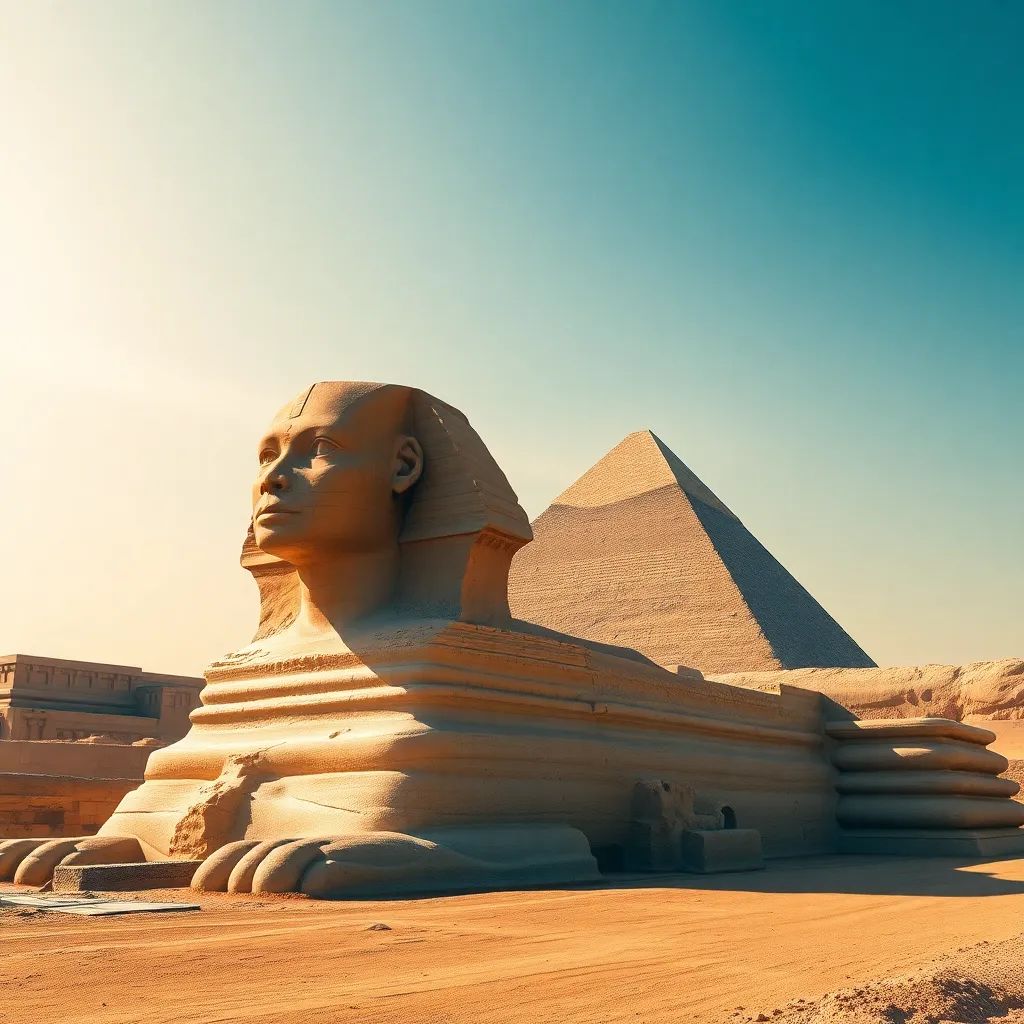The Sphinx: A Reflection of the Pharaoh’s Power
I. Introduction
The Great Sphinx of Giza, one of the most iconic monuments of ancient Egypt, stands as a colossal testament to the ingenuity and spirit of a civilization that flourished thousands of years ago. This enigmatic structure, with the body of a lion and the head of a pharaoh, holds a significant place in ancient Egyptian culture, representing not just the artistic prowess of its builders but also the cultural and spiritual values of the society.
The Sphinx serves as a monumental symbol of the Pharaoh’s power, divine authority, and cultural legacy. As an enduring emblem of ancient Egypt, it continues to intrigue historians, archaeologists, and tourists alike, inviting exploration into its rich history and meaning.
II. Historical Context of the Sphinx
The origins of the Sphinx trace back to the reign of Pharaoh Khafre (c. 2570 BC), who is believed to have commissioned its construction as part of his mortuary complex. The Sphinx, carved from a single limestone ridge, showcases the architectural and artistic innovations of the Old Kingdom period.
- Construction during the reign of Pharaoh Khafre
- Integration into the Giza pyramid complex, alongside the Great Pyramid and the Pyramid of Khafre
- Use of advanced techniques in sculpture and construction
Within the broader context of Giza’s pyramid complex, the Sphinx serves not only as a guardian of the pharaoh’s tomb but also as a symbol of the monumental architecture that characterizes ancient Egyptian civilization.
III. Symbolism of the Sphinx
The Sphinx represents the pharaoh as a hybrid creature, combining the strength and ferocity of a lion with the intelligence and authority of a human. This unique representation embodies the power and protection that the pharaoh was believed to possess.
- Symbol of power: The lion’s body signifies strength and authority.
- Human head: Represents the divine connection and intellect of the pharaoh.
- Connection to solar deities: The Sphinx is often associated with the sun god Ra, further solidifying its role in the afterlife beliefs of ancient Egyptians.
Moreover, the Sphinx’s association with solar deities highlights its importance in the spiritual and cosmological views of the ancient Egyptians, emphasizing the pharaoh’s role as a mediator between the gods and the people.
IV. The Sphinx and Pharaoh’s Authority
The Sphinx was more than just a monumental sculpture; it functioned as a guardian of the Pharaoh’s tomb and a symbol of his divine right to rule. Its presence in Giza carried significant political implications, reinforcing the pharaoh’s authority in both life and death.
- Guardian of the Pharaoh’s tomb: The Sphinx was believed to protect the deceased pharaoh, ensuring safe passage to the afterlife.
- Political symbolism: The Sphinx’s grandeur asserted the power of the pharaoh over his subjects and neighboring regions.
- Divine right to rule: The Sphinx affirmed the belief that pharaohs were chosen by the gods to lead, reinforcing their status as both political and spiritual leaders.
This powerful symbolism ensured that the Sphinx would be remembered as an enduring legacy of the Pharaohs’ might throughout the ages.
V. Artistic and Architectural Significance
The design and construction techniques of the Sphinx highlight the artistic excellence of ancient Egyptian civilization. Carved from a single limestone monolith, the Sphinx measures about 73 meters long and 20 meters high, making it one of the largest sculptures in the world.
- Design: The proportions and details of the Sphinx reflect the advanced understanding of anatomy and proportion among ancient Egyptian artists.
- Construction techniques: The use of tools and methods to carve such a large structure from natural rock demonstrates the capabilities of the engineers and laborers of the time.
- Influence on Egyptian art: The Sphinx set a precedent for monumental sculptures, influencing subsequent artistic endeavors in ancient Egypt.
Its artistic significance is further emphasized when compared to other monumental sculptures, such as the statues of Ramses II and the various representations of deities, showcasing the rich artistic tradition of ancient Egypt.
VI. The Sphinx in Ancient Egyptian Society
The Sphinx played a vital role in ancient Egyptian society beyond its physical presence. It was a site for religious rituals and ceremonies, where offerings were made to honor the pharaoh and the gods.
- Religious rituals: The Sphinx was involved in various ceremonies that celebrated the divine connection of the pharaoh.
- Public perception: Myths surrounding the Sphinx, including tales of its riddles and wisdom, contributed to its legendary status.
- Daily life: The Sphinx was a constant reminder of the pharaoh’s power and protection, influencing the lives of the ancient Egyptians in their daily routines.
As such, the Sphinx was not only a monumental structure but also a pivotal figure in the spiritual and cultural life of ancient Egypt.
VII. The Sphinx in Modern Times
In modern times, the Great Sphinx of Giza continues to be a subject of fascination and study. Archaeological discoveries and restoration efforts have sought to preserve this ancient wonder for future generations.
- Archaeological discoveries: Ongoing excavations have revealed new insights into the construction and purpose of the Sphinx.
- Restoration efforts: Various projects have aimed to protect the Sphinx from erosion and environmental damage.
- Cultural impact: The Sphinx remains a significant draw for tourism, symbolizing the allure of ancient Egypt.
Debates about the Sphinx’s origins and meaning continue among scholars, adding to the mystique surrounding this ancient monument and its place in history.
VIII. Conclusion
In summary, the Great Sphinx of Giza stands as a powerful symbol of the pharaoh’s authority, divine right, and cultural legacy. Its historical significance, artistic achievements, and role within ancient Egyptian society highlight the importance of this monumental structure.
The enduring legacy of the Sphinx continues to captivate our imaginations, reminding us of the rich history and accomplishments of ancient Egypt. Preserving this ancient monument is crucial to ensuring that future generations can appreciate its significance and the stories it holds.




